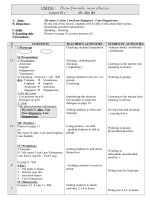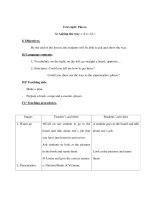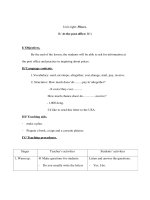28817 wonderful places
Bạn đang xem bản rút gọn của tài liệu. Xem và tải ngay bản đầy đủ của tài liệu tại đây (224.41 KB, 1 trang )
1
2
Taj Mahal is a monument located in Agra, India.
It was built by the Mughal Emperor Shah Jahan
as a mausoleum for his Persian wife Mumtaz Mahal.
It took 23 years to complete it (1630 - 1653) and it is a
masterpiece of Mughal architecture. The complex of the Taj
Mahal covers an area of approximately 580 m Ч 300 m. All the
beauty of Shah Jahan’s love for his wife is seen in the Taj
Mahal. Isn’t it amazing that the love of Shah Jahan and
Mumtaz Mahal still speaks and is alive in the white marbled
beauty? The true story never ends even when Shah Jahan was
buried next to his wife after his death. The story continues
even at this age.
The Leaning Tower of Pisa is situated behind the
Cathedral and is the third oldest structure in
Pisa's Cathedral Square. Construction of the tower
was made in three stages across 177 years. The
tower began to sink after construction had progressed to
the second floor in 1178. In 1987 the tower was declared as
part of the UNESCO World Heritage Site. After a decade
of reconstruction and stabilization efforts, the tower was
reopened to the public on December 15, 2001. In May 2008,
after the removal of another 70 metric tons of ground,
engineers announced that the Tower had been stabilized
such that it had stopped moving for the first time in its
history.
3
The Sydney Opera House is a unique
building with several white sail-shaped
shells as its roof. Architects from some 30
countries took part in the international
competition for a design of the building in 1956. In January
1957 Danish architect Jorn Utzon was announced the winner.
Construction began in 1959. Now it is the best-known
landmark. It is a multipurpose facility with the 2,679-seat
Hall. There are also three theatres of different sizes and
configurations for stage plays, film screenings, and smaller
musical performances. The building also houses restaurants
and a professional recording studio. In 2007 this building was
designated a UNESCO World Heritage site.
The Eiffel Tower is the most widely recognized
national landmark in the world. The Eiffel Tower is
a 320-metre tower constructed by engineer
Gustave Eiffel for an international exposition in
Paris in 1889. The tower was intended for
permanent display, and it survives to this day intact. There
are elevators that can take you to the top. Double-decked
elevators to the first and second levels are specially
designed to ascend along the steep incline of the tower’s
legs. The net between the second and third platforms is
intended to protect painters working on that part of the
tower. More than two American-style football fields would
fit comfortably in the area covered by the tower’s base.
5
Saint Basil's Cathedral is a Russian Orthodox
Church built on the Red Square in Moscow in
1555–61 on order of Ivan the Terrible. St. Basil's
marks the geometric center of Moscow. It was the
city's tallest building until the completion of the
Ivan the Great Bell Tower in 1600. The building is shaped as a
flame of a bonfire rising into the sky. Its design has no
analogues in Russian architecture: "It is like no other Russian
building. Nothing similar can be found in the entire millennium
of Byzantine tradition from the fifth to fifteenth century ...
a strangeness that astonishes by its unexpectedness,
complexity and dazzling interleaving of the manifold details
of its design."
The Statue of Liberty is situated on Liberty
6
Island in the harbor of New York. It was presented
to the American people by the French government
on the hundredth anniversary of American Independence. The Statue of Liberty was constructed by
the French sculptor Frederic Bartholdi. It is a bronze female
figure about 50 metres high facing the ocean from Liberty
Island. In the right hand you can see a torch of liberty. It can
be seen at night for many kilometers. The statue stands on a
pedestal of about 50 metres high. The statue is hollow and a
staircase runs inside the figure to the top. From there you
can enjoy the beautiful panorama of New York and its harbor.
7
The Great Wall of China is a series of fortifications
made of stone, brick, tamped earth, wood, and
other materials, built across the historical northern
borders of China to protect the Chinese Empire or
its prototypical states against various warlike peoples or
8. Answer the questions to all the texts:
forces. Several walls were built in the 7th century BC; they
later joined together and made bigger, stronger, and unified
now are collectively referred to as the Great Wall. Especially
famous is the wall built between 220–206 BC by the first
Emperor of China, Qin Shi Huang. Little of that wall remains.
Since then, the Great Wall has on and off been rebuilt,
maintained, enhanced; the majority of the existing wall was
reconstructed during the Ming Dynasty.
1. Where is Taj Mahal situated? 2. Whom is it devoted to?
3. What is special with the Leaning Tower of Pisa? 4. Is it
still falling now? 5. When did the design of the Sydney Opera
House begin? 6. Who designed it? 7. What is located there?
8. How long is the Eiffel Tower? 9. When was it built? 10.
Who built it? 11. When was St. Basil’s Cathedral built? 12.
Is it a unique building? 13. Who presented the Statue of
Liberty to America? 14. How long is this statue? 15. Who
constructed it? 16. What is the Great Wall of China? 17.
What was its function?
All the texts are adapted from
4









